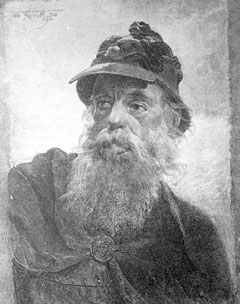| Siege of Pemaquid (1689) | |||||||
|---|---|---|---|---|---|---|---|
| Part of King William's War | |||||||
 Baron Jean-Vincent d'Abbadie de Saint-Castin | |||||||
| |||||||
| Belligerents | |||||||
|
Acadia Abenaki |
| ||||||
| Commanders and leaders | |||||||
| St. Castin and Father Louis-Pierre Thury and Chief Moxus | Lieutenant James Weems | ||||||
| Strength | |||||||
| unknown | unknown | ||||||
| Casualties and losses | |||||||
| unknown | unknown | ||||||
| |||||
The Siege of Pemaquid (August 2–3, 1689) was a successful attack by a large band of Abenaki Indians on the English fort at Pemaquid, Fort Charles, then the easternmost outpost of colonial Massachusetts (present-day Bristol, Maine). The French-Abenaki attack was led by Jean-Vincent d'Abbadie de Saint-Castin and Father Louis-Pierre Thury and Chief Moxus.[1] The fall of Pemaquid was a significant setback to the English. It pushed the frontier back to Casco (Falmouth), Maine.[2]
The fort at Pemaquid was under the command of Lieutenant James Weems and was significantly under strength after most of its garrison had deserted in the wake of the revolt and overthrow of Governor Andros at Boston earlier in the year. The complement of soldiers was reduced to thirty and many of these were in a mutinous state. The Indian force surrounded the fort, capturing or killing most of the settlers in the countryside about the fort. Lieutenant Weems provided a defense for a day, but after taking heavy casualties (Weems and 23 of the garrison having been wounded), he surrendered. The Abenaki allowed Weems and his men to return to Boston.[3] On August 4, the Abenaki burned the fort and the nearby settlement of Jamestown.
One of the captives the Maliseet took back to their main village Meductic, on the Saint John River was John Gyles, who created one of the few Captivity narratives to come out of Nova Scotia/ Acadia.. (John Gyles' brother James was also captured by the Penobscot and taken back to Fort Penobscot (present-day Castine, Maine) where he was tortured and burned alive at the stake.)[4]
The Fort at Pemaquid was rebuilt in stone in 1692–93 and renamed Fort William Henry. Four years later d'Abbadie de Saint-Castin and the Wabanaki Confederacy captured it again.
References[]
- ↑ Drake. The Border Wars of New England. p. 28
- ↑ Conquering the American wilderness: the triumph of European warfare in ... By Guy Chet, p. 81
- ↑ Webster, John Clarence. Acadia at the End of the Seventeenth Century. Saint John, NB, The New Brunswick Museum, 1979.
- ↑ Raymond, p. 23; In Castine, Maine, a plaque on Dyce Head Lighthouse Rd. says: UPON THESE HEIGHTS, in 1692, James Giles [brother of John Gyles], a boy, and an Englishman, taken at Casco [in the Siege of Pemaquid (1689)], held in slavery by Madockawando for attempting to escape, were tortured by fire, compelled to eat their noses and ears and then burned to death at the stake.
- Paltsits, Victor. The Depredation at Pemaquid in August, 1689
- Relation du Combat de Caribas par M. Thury, missionaire, 1689, vol. 1 Doc. pub. a Quebec, p. 478
The original article can be found at Siege of Pemaquid (1689) and the edit history here.